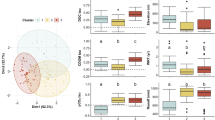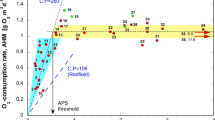Abstract
Productivity denotes the rate of biomass synthesis in ecosystems and is a fundamental characteristic that frames ecosystem function and management. Limitation of productivity by nutrient availability is an established paradigm for lake ecosystems1,2,3. Here, we assess the relevance of this paradigm for a majority of the world’s small, nutrient-poor lakes, with different concentrations of coloured organic matter4,5. By comparing small unproductive lakes along a water colour gradient, we show that coloured terrestrial organic matter controls the key process for new biomass synthesis (the benthic primary production) through its effects on light attenuation. We also show that this translates into effects on production and biomass of higher trophic levels (benthic invertebrates and fish). These results are inconsistent with the idea that nutrient supply primarily controls lake productivity, and we propose that a large share of the world’s unproductive lakes, within natural variations of organic carbon and nutrient input, are limited by light and not by nutrients. We anticipate that our result will have implications for understanding lake ecosystem function and responses to environmental change. Catchment export of coloured organic matter is sensitive to short-term natural variability and long-term, large-scale changes, driven by climate and different anthropogenic influences6,7. Consequently, changes in terrestrial carbon cycling will have pronounced effects on most lake ecosystems by mediating changes in light climate and productivity of lakes.
This is a preview of subscription content, access via your institution
Access options
Subscribe to this journal
Receive 51 print issues and online access
$199.00 per year
only $3.90 per issue
Buy this article
- Purchase on Springer Link
- Instant access to full article PDF
Prices may be subject to local taxes which are calculated during checkout




Similar content being viewed by others

References
Schindler, D. W. Evolution of phosphorus limitation in lakes. Science 195, 260–262 (1977)
Sterner, R. W. On the phosphorus limitation paradigm for lakes. Int. Rev. Hydrobiol. 93, 433–445 (2008)
Carpenter, S. R. Phosphorus control is critical to mitigating eutrophication. Proc. Natl Acad. Sci. USA 105, 11039–11040 (2008)
Downing, J. A. et al. The global abundance and size distribution of lakes, ponds, and impoundments. Limnol. Oceanogr. 51, 2388–2397 (2006)
Sobek, S., Tranvik, L. J., Prairie, Y. T., Kortelainen, P. & Cole, J. J. Patterns and regulation of dissolved organic carbon: An analysis of 7,500 widely distributed lakes. Limnol. Oceanogr. 52, 1208–1219 (2007)
Tranvik, L. J. & Jansson, M. Climate change — terrestrial export of organic carbon. Nature 415, 861–862 (2002)
Roulet, N. & Moore, T. R. Environmental chemistry: browning the waters. Nature 444, 283–284 (2006)
Vadeboncoeur, Y. et al. From Greenland to green lakes: cultural eutrophication and the loss of benthic pathways in lakes. Limnol. Oceanogr. 48, 1408–1418 (2003)
Hanson, J. M. & Leggett, W. C. Empirical predictions of fish biomass and yield. Can. J. Fish. Aquat. Sci. 39, 257–263 (1982)
Jeppesen, E. et al. Lake and catchment management in Denmark. Hydrobiologia 395/396, 419–432 (1999)
Vander Zanden, M. J. & Vadeboncoeur, Y. Fishes as integrators of benthic and pelagic food webs in lakes. Ecology 83, 2152–2161 (2002)
Karlsson, J. & Byström, P. Littoral energy mobilization dominates energy supply for top consumers in subarctic lakes. Limnol. Oceanogr. 50, 538–543 (2005)
Jones, R. I. The influence of humic substances on lacustrine planktonic food-chains. Hydrobiologia 229, 73–91 (1992)
Meili, M. Sources, concentrations and characteristics of organic matter in softwater lakes and streams of the Swedish forest region. Hydrobiologia 229, 23–41 (1992)
Carpenter, S. R., Cole, J. J., Kitchell, J. F. & Pace, M. L. Impact of dissolved organic carbon, phosphorus, and grazing on phytoplankton biomass and production in experimental lakes. Limnol. Oceanogr. 43, 73–80 (1998)
Karlsson, J., Jonsson, A., Meili, M. & Jansson, M. Control of zooplankton dependence on allochthonous organic carbon in humic and clear-water lakes in northern Sweden. Limnol. Oceanogr. 48, 269–276 (2003)
Ask, J. et al. Whole-lake estimates of carbon flux through algae and bacteria in benthic and pelagic habitats of clear-water lakes. Ecology. 90, 1923–1932 (2009)
Jansson, M., Persson, L., De Roos, A. M., Jones, R. I. & Tranvik, L. J. Terrestrial carbon and intraspecific size-variation shape lake ecosystems. Trends Ecol. Evol. 22, 316–322 (2007)
Carpenter, S. R. et al. Ecosystem subsidies: Terrestrial support of aquatic food webs from 13C addition to contrasting lakes. Ecology 86, 2737–2750 (2005)
Svärdson, G. Interspecific Population Dominance in Fish Communities of Scandinavian Lakes. Report No. 55, 144–171 (Institute of Freshwater Research, 1976)
Hansson, L.-A. Factors regulating periphytic algal biomass. Limnol. Oceanogr. 37, 322–328 (1992)
Mulholland, P. J. in Aquatic Ecosystems: Interactivity of Dissolved Organic Matter (eds Findlay, S. & Sinsabaugh R. L.) Ch. 6, 139–159 (Academic, 2003)
Hope, D., Billett, M. F. & Cresser, M. S. A review of the export of carbon in river water: fluxes and processes. Environ. Pollut. 84, 301–324 (1994)
Karlsson, J., Jansson, M. & Jonsson, A. Similar relationships between pelagic primary and bacterial production in clearwater and humic lakes. Ecology 83, 2902–2910 (2002)
McCauley, E. in A Manual on Methods for the Assessment of Secondary Productivity in Fresh Waters 2nd edn (eds Downing, J. A. & Riegler, F. H.) 228–265 (Blackwell Scientific, 1984)
Persson, L., Andersson, J., Wahlstrom, E. & Eklov, P. Size-specific interactions in lake systems: predator gape limitation and prey growth rate and mortality. Ecology 77, 900–911 (1996)
Cuthbert, I. D. & del Giorgio, P. Towards a standard method of measuring color in freshwater. Limnol. Oceanogr. 37, 1319–1326 (1992)
Eloranta, P. Light penetration in different types of lakes in Central Finland. Holarct. Ecol. 1, 362–366 (1978)
Blenckner, T., Jarvinen, M. & Weyhenmeyer, G. A. Atmospheric circulation and its impact on ice phenology in Scandinavia. Boreal Environ. Res. 9, 371–380 (2004)
McQuarrie, A. D. R. & Tsai, C.-L. Regression and Time Series Model Selection (World Scientific, 1998)
Acknowledgements
The study was part of the research environment LEREC (Lake Ecosystem Response to Environmental Change), financially supported by Formas (the Swedish Research Council for Environment, Agricultural Sciences and Spatial Planning). We thank the Abisko Scientific Research Station, the Swedish Meteorological and Hydrological Institute and the Umeå Marine Sciences Centre for providing PAR data, M. Mörth and J. Johansson for chemical analysis and C. Hein for language editing.
Author Contributions J.K., P.B., L.P. and M.J. contributed to study design. J.K., P.B., J.A. and P.A. contributed to sampling and analysis of data. J.K. and M.J. wrote the paper. All authors commented on the manuscript.
Author information
Authors and Affiliations
Corresponding author
Supplementary information
Supplementary Information
This file contains Supplementary Tables 1-4, Supplementary Figure 1 with Legend and Supplementary References. (PDF 186 kb)
Rights and permissions
About this article
Cite this article
Karlsson, J., Byström, P., Ask, J. et al. Light limitation of nutrient-poor lake ecosystems. Nature 460, 506–509 (2009). https://doi.org/10.1038/nature08179
Received:
Accepted:
Issue Date:
DOI: https://doi.org/10.1038/nature08179
This article is cited by
-
Roles and sources of B vitamins in the marine ecosystem
Reviews in Fish Biology and Fisheries (2024)
-
Dissolved greenhouse gas (CO2, CH4, and N2O) emissions from highland lakes of the Andes cordillera in Northern Ecuador
Aquatic Sciences (2024)
-
The hub of the wheel or hitchhikers? The potential influence of large avian herbivores on other trophic levels in wetland ecosystems
Hydrobiologia (2024)
-
Linkages between pelagic and benthic biota in a deteriorated coastal lake after restoration, Maruit, Egypt
Environmental Monitoring and Assessment (2023)
-
Epiphytes support aquatic consumers of a large floodplain lake ecosystem in the southern Gulf of Mexico
Aquatic Sciences (2023)
Comments
By submitting a comment you agree to abide by our Terms and Community Guidelines. If you find something abusive or that does not comply with our terms or guidelines please flag it as inappropriate.


